William Saliba (192cm/6’4”, 85kg/187lbs) hasn’t had much of an opportunity to make an impact at Arsenal since moving to the Emirates Stadium in the summer of 2019 for €30m (£27m). He was loaned to Saint-Étienne, where he’d progressed through the youth ranks since 2016, for the 2019/20 season, while he spent the first portion of this past season out of sight and out of mind for Mikel Arteta.
Saliba didn’t make a first-team appearance for the Gunners in the 2020/21 campaign before he was sent back to Ligue 1 for the second half of the season, this time joining Nice. After making that loan switch, the 20-year-old Frenchman was quite outspoken about his difficult start to the season, telling the media that Arteta failed to give him “a chance to rediscover [his] rhythm” before deciding that Saliba was not ready for Arsenal’s first-team and declaring: “Even though I’m young, I’ve come to be a leader.”
The Saint-Étienne academy product was a leader in several different ways during his loan stint at Nice, where despite Arteta’s uncertainty, Saliba shone as a first-team asset – a role he’ll undoubtedly hope to continue playing on his return to the EPL giants. This tactical analysis, in the form of a scout report, provides analysis of Saliba’s impressive displays at Nice during the second half of the 2020/21 campaign, which earned him a place on the shortlist for the Ligue 1 Centre Back of the Season award. We’ll discuss some key strengths and weaknesses to Saliba’s game, what role he played in Adrian Ursea’s tactics, and how he could potentially fit into Mikel Arteta’s plans for next term in our scout report.
Ball-carrying
Some of Saliba’s greatest strengths are in his on-the-ball quality and with Nice being one of the most possession-based sides in Ligue 1 this past season, keeping an average of 54.1% possession, more than all but four other teams in France’s top-flight, Les Aiglons provided a good environment for Saliba to showcase his abilities on the ball.
Before his season-ending cruciate ligament injury, Dante was one of Nice’s most important players in terms of ball progression. He typically occupied the left centre-back position for Les Aiglons. While Saliba couldn’t replicate everything that Dante brought to this team, with the Brazilian having been a central figure to his side’s tactics before his injury, the Frenchman’s January loan signing was Nice’s attempt to replace the 37-year-old former Bayern Munich man and looking at how Saliba performed at Allianz Riviera, it’s difficult to fault the Alpes-Maritimes-based side’s recruitment.
Saliba ended the 2020/21 Ligue 1 campaign having progressed the ball 7.1m per minute. This is a further distance, per minute, than any other Ligue 1 player progressed the ball, including Dante, who came second on that list, highlighting the important role that Nice’s centre-backs played in ball progression.
The Arsenal loanee tended to progress play via ball-carrying more than passing. He also progressed play via runs more, in terms of distance, than any other player in Ligue 1 this past season, including PSG attacker Neymar, who was second on that list, indicating the central role that Saliba and his ball-carrying played for Ursea following his January arrival at Nice.
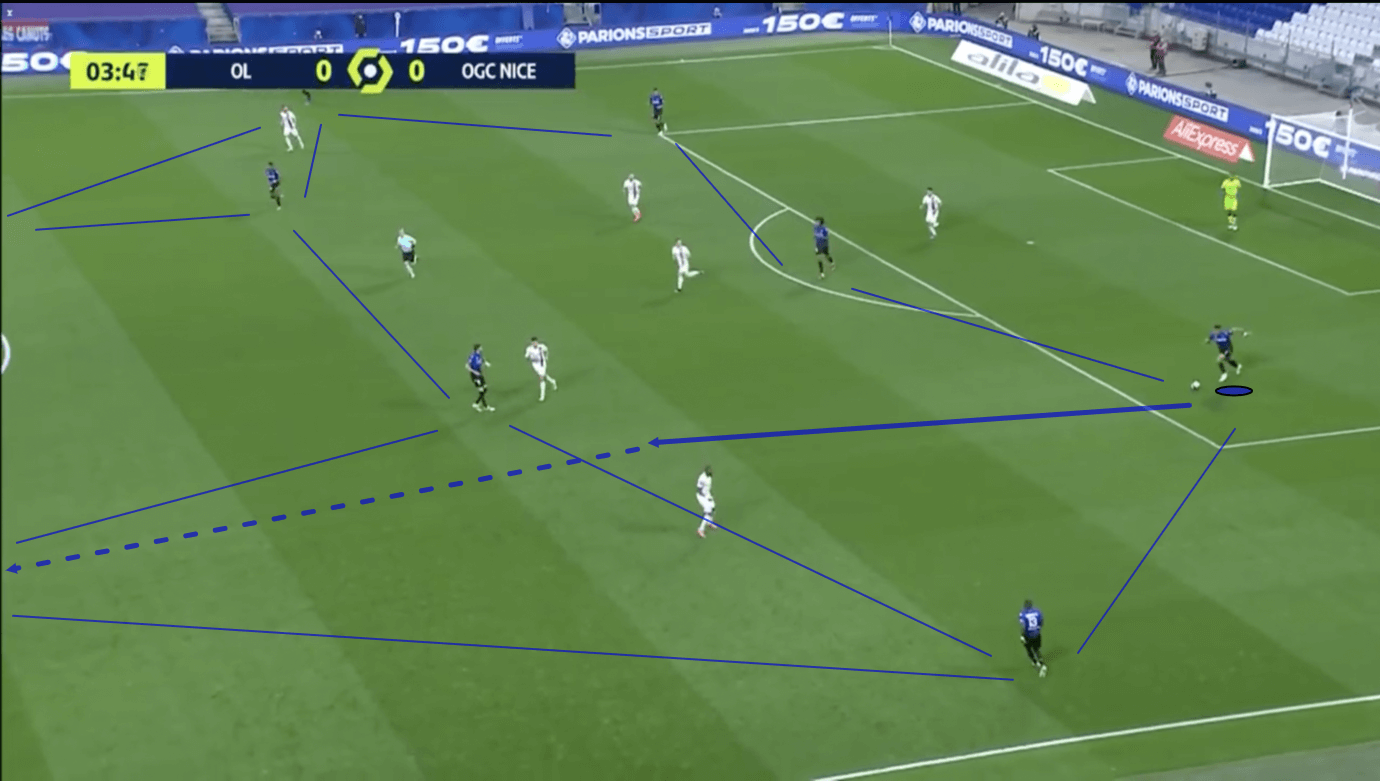
Figure 1 shows how Nice look in build-up. While they generally played with two centre-back formations, Les Aiglons tended to build up with three players in the traditional centre-back roles quite a lot, which we see here. Regardless of whether there were two or three centre-backs in the lineup at a given time, Saliba generally occupied this left centre-back position.
While he’s right-footed, and not extremely comfortable playing with his left foot, this is a role he’s familiar with, having played at left centre-back often for Saint-Étienne. This is also where we could see him line up for Arsenal, with David Luiz, who frequently played as a left centre-back, set to leave the club after his contract expires this month.
Nice are a very patient side on the ball and it’s common to see them play lots of lateral passes to create a clear opening for ball progression and chance creation. As a result, Saliba had to be disciplined on the ball a lot of the time, which he managed to do very reliably.
However, a big part of his role was being a risk-taker because of his on-the-ball ability. He’s confident and comfortable when carrying the ball forward, so this is a role that suited him and it was common to see him picking up the ball in positions like this. From here, Saliba would often aim to exploit space ahead of him, while carrying the ball until a good opportunity for a progressive pass opened up or he attracted pressure from a nearby opposition defender, thus naturally creating space for a nearby teammate who he could pass to.
As this passage of play moved on, an opportunity to pass into the feet of his teammate in the left half-space opened up, which Saliba gladly took. It was common to see him look for the furthest forward ground passing option, as this put Nice in a more dangerous position. This vision and pass selection is typical of Saliba. In addition to his technical quality, confidence and bravery in possession, he has got a great mind for seeing and selecting dangerous passes.
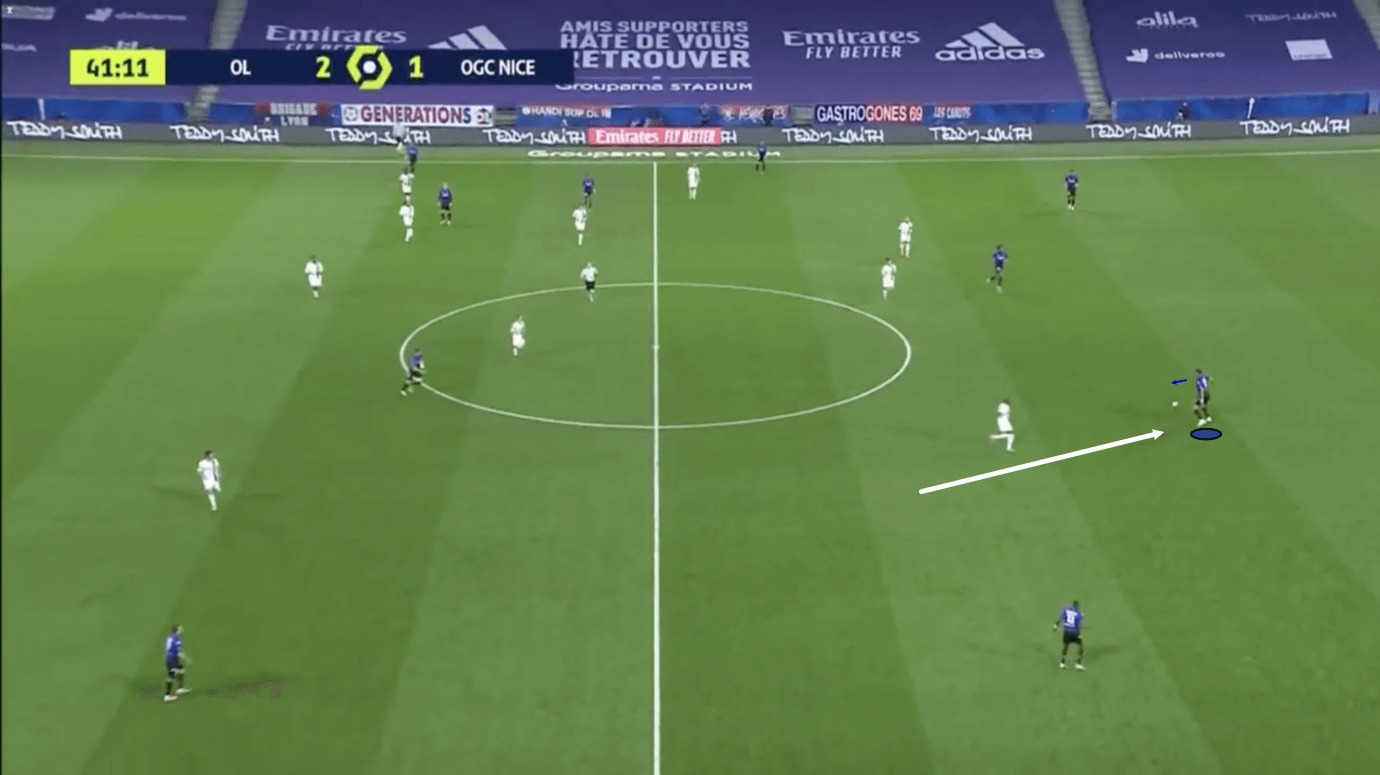
Saliba was often tasked with playing the ball upfield and getting Nice through the opposition’s defensive shape. If progressive ground passing options presented themselves, he’d generally take them, but a lot of the time the opposition covered these passing options either via their cover shadow while pressing Saliba or just marking the passing options tightly. In figure 2, we see an example of Saliba being pressed and prevented from playing the ball along the ground to the left-winger by that pressing player’s cover shadow, as well as the central attacker who he’d ideally pass to here but is being marked tightly.
It’s common for players, including Saliba, to continue circulating the ball laterally and continue searching for an opening patiently. It’s common to see Saliba take players on more, however. He’s happy to back his ability on the ball and carry it upfield. One way it’s common to see him do this is by allowing the player pressing him to get very close before knocking it around him, running upfield and aiming to either create a better passing angle or create space for a teammate by pulling their marker out of position via his dribble.
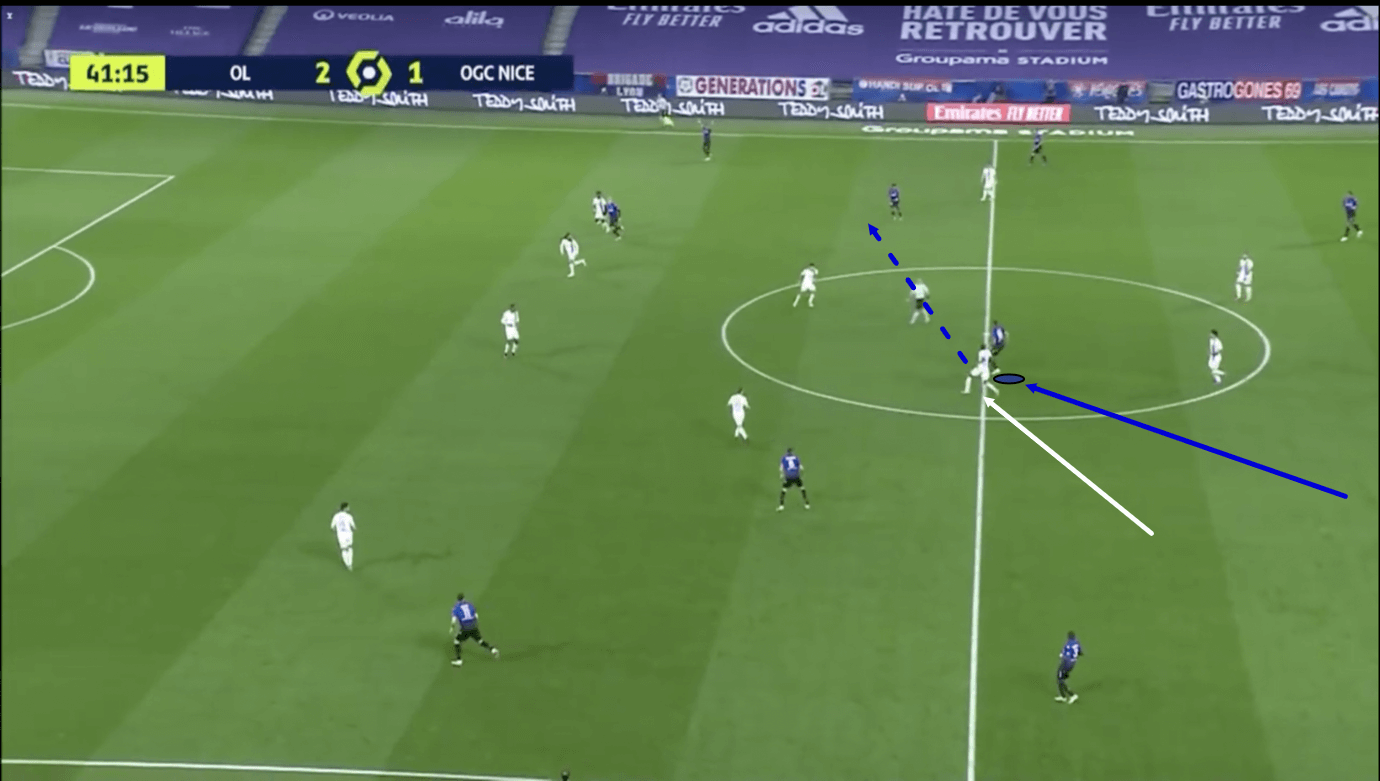
As play moves on into figure 3, we see that Saliba managed to get around this player via his dribble and as he progressed, an opposition midfielder on his right moved more central to try and control the space Saliba is targeting with his run. This leads to a passing option freeing up in the right half-space, which the centre-back takes, sending Nice off on a dangerous attack.
This highlights Saliba’s confidence, in that he’s happy to let the pressing player get close, confident that he’ll beat them with his dribbling ability, and his quality on the ball, as he succeeded in beating the player and put Nice in a very good position. This is what Saliba offers on the ball via his ball-carrying quality.
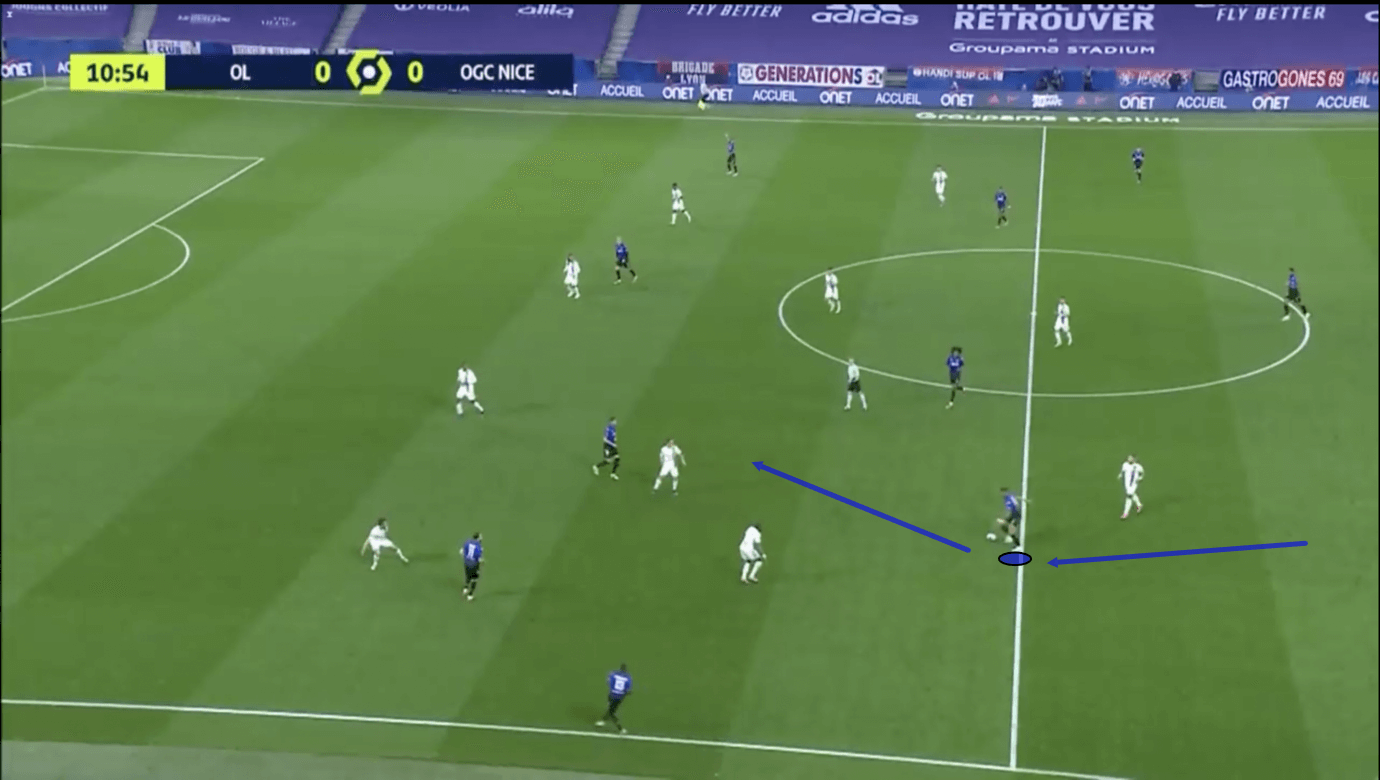
We see another example of Saliba’s ball-carrying quality here. In figure 4, Nice are playing slightly higher than they were in the previous example, with the opposition in a similar mid-block. Here, Saliba isn’t being pressed much, having already progressed past the opposition’s first line, but his progressive passing options are all being marked quite tightly. Instead of playing backwards or sideways in search of an opening, he looks to push Nice forward more often than many other players would despite those forward passing options being blocked off, by carrying the ball upfield himself.
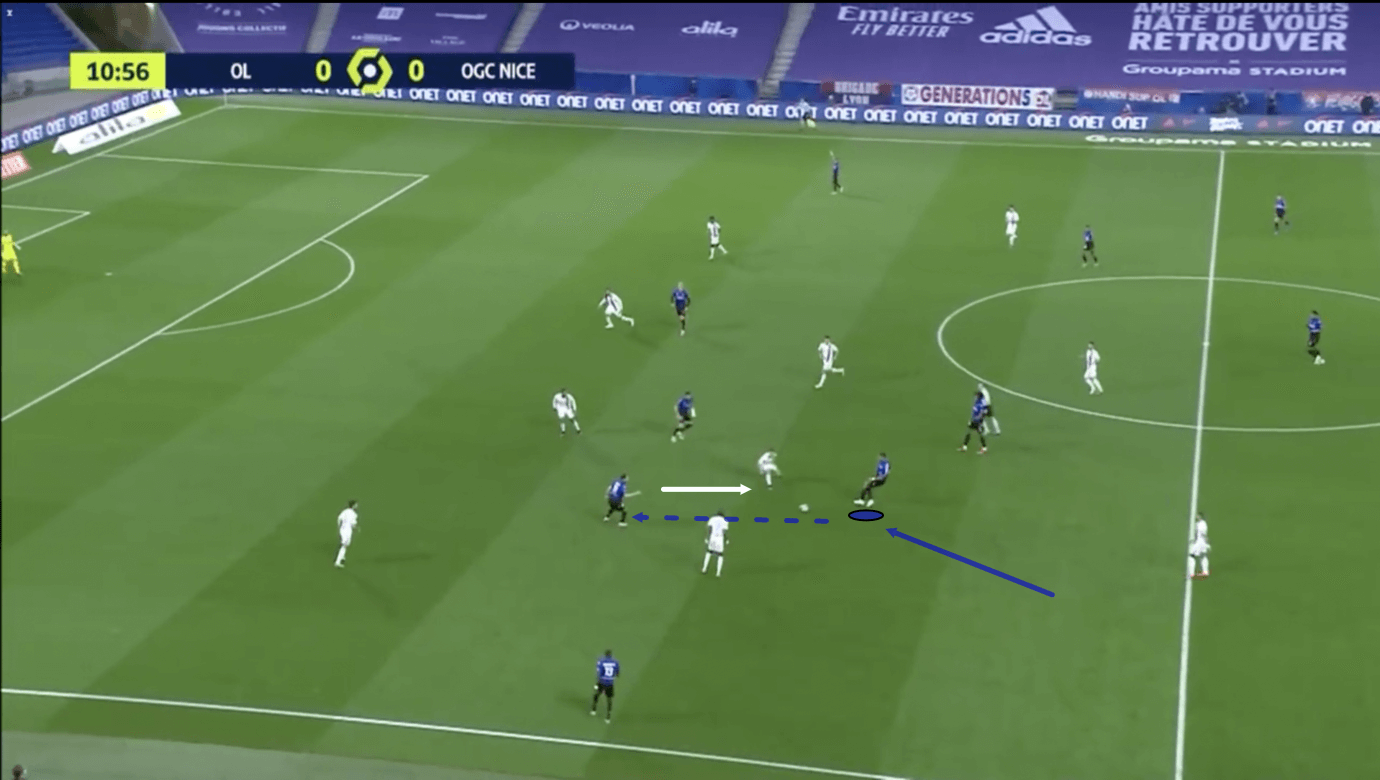
In figure 5, we see that Saliba’s run eventually created space for his teammate in the left half-space as his marker was drawn out of position to close down Saliba. Alert to this, the centre-back reacted by playing the ball into his teammate’s feet, allowing him to get on the ball, allowing Nice to target the opposition’s four-man backline with their five attackers who we see in front of them. Again, we see how Saliba’s confidence and ball-carrying quality combine to set Nice up for dangerous attacks from this passage of play.
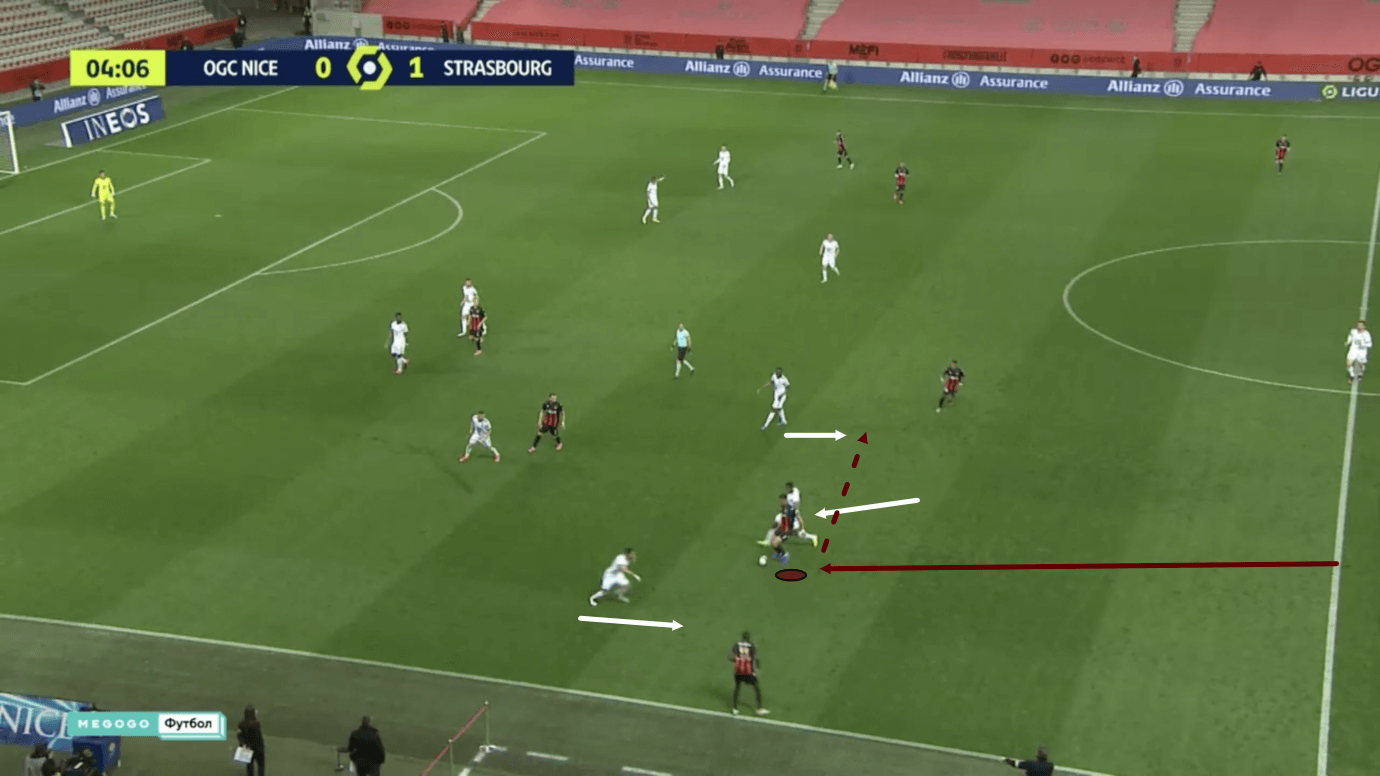
Saliba’s confidence and tendency to carry the ball upfield can backfire at times, of course. It’s called risk-taking for a reason – there’s always a chance it can go wrong. This is the price Nice and Saliba pay to create the scenarios that we analysed in the previous two passages of play. Here in figure 6, we see that as Saliba carried the ball upfield after attempting to progress past the pressing player, that player kept up with him by tracking back, forcing the centre-back away from the centre and into a cul-de-sac, as the opposition’s wide midfielder also pressed the defender, creating a 2v1 versus Saliba.
The 20-year-old could potentially have used the wide passing option behind him on the left-wing here, but bear in mind that this player would’ve come under plenty of pressure from the opposition’s right midfielder who we see pressing Saliba here and Saliba is quite an attack-minded player, so it’s not a big surprise that he opted to try and play the ball into the centre anyway. As play moves on, Saliba turns and attempts to pass to the central midfielder who we can see dropping to make himself available to the centre-back here. Saliba’s pass is slightly wayward, however, and is intercepted by the opposition, who kickstart a threatening counterattack as a result.
This passage of play highlights how Saliba’s aggressive ball-carrying can create problems for his team at times, and this type of scenario is something that Arteta will be aware of on the centre-back’s return to Arsenal and will want to limit if Saliba is part of his first-team plans for next season.
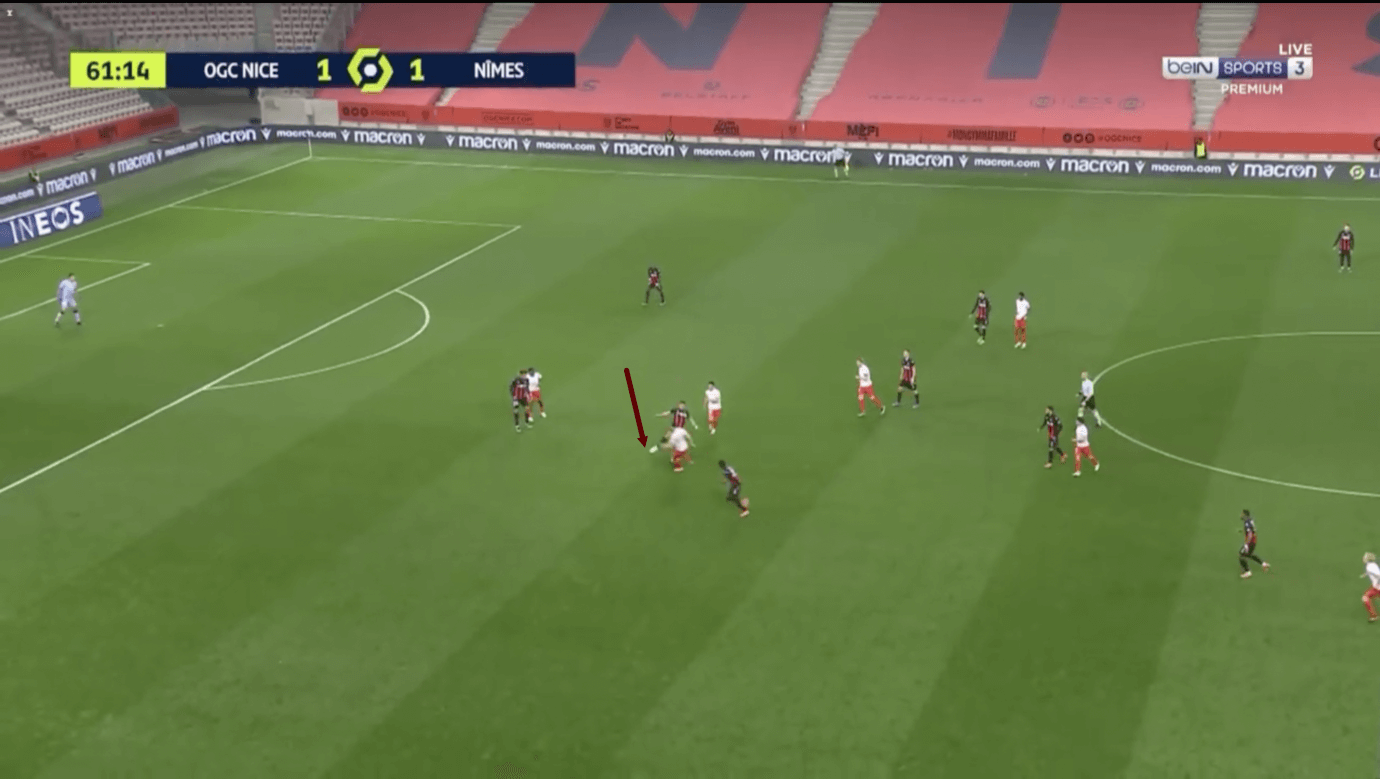
As we’ll discuss later on in this tactical analysis piece, Saliba doesn’t often go to ground. Generally, we only see him go to ground when he’s created a problem for his team by overcarrying the ball and getting dispossessed in a potentially dangerous position, which we see in figure 7. Here, Saliba had carried the ball out from the back to drive his team forward. However, as this image shows, he got too close to one particular opposition player, who managed to get control of the ball. Desperate to prevent his error from being exposed, Saliba dived into a tackle.
This particular scenario doesn’t occur very often but it has happened on a few occasions. It can lead to free-kicks going against Saliba, or the 20-year-old just being beaten as he goes to ground, leaving a big gap in the defence. However, this highlights another risk of his ball-carrying that Arteta will be aware of and want to work on for next season.
Passing
There are positives and negatives to Saliba’s passing game which have been highlighted during his loan stint at Nice, as they were during his time at Saint-Étienne. Firstly, it’s important to remember that Saliba was central to Nice’s build-up play and ball progression. He saw a lot of the ball this past season which inevitably led to him playing a lot of passes, many of which had to be safe, lateral passes as part of Nice’s patient build-up.
Saliba proved himself reliable in this role. To highlight his central role within Nice’s build-up and ball progression phases, Saliba played an average of 67.28 passes per 90 during his time with Les Aiglons – the 16th-most passes per 90 of any Ligue 1 player for the 2020/21 campaign. While playing lots of passes, Saliba’s reliability is evident from the fact that he ended the season with a 92.89% pass success rate – the second-best of any Nice player and 17th-best of any player in Ligue 1.
Nine of Saliba’s 67.28 passes per 90 were progressive passes, on average, while he had a progressive pass accuracy rate of 74.74% at the end of the season. Neither of these numbers rank him amongst Ligue 1’s elite, but they’re not unimpressive either. He’s fairly reliable when playing progressive passes and he does so pretty often. Saliba is definitely at his best when making progressive runs and carrying the ball upfield though and there is some room for improvement with his progressive passing.
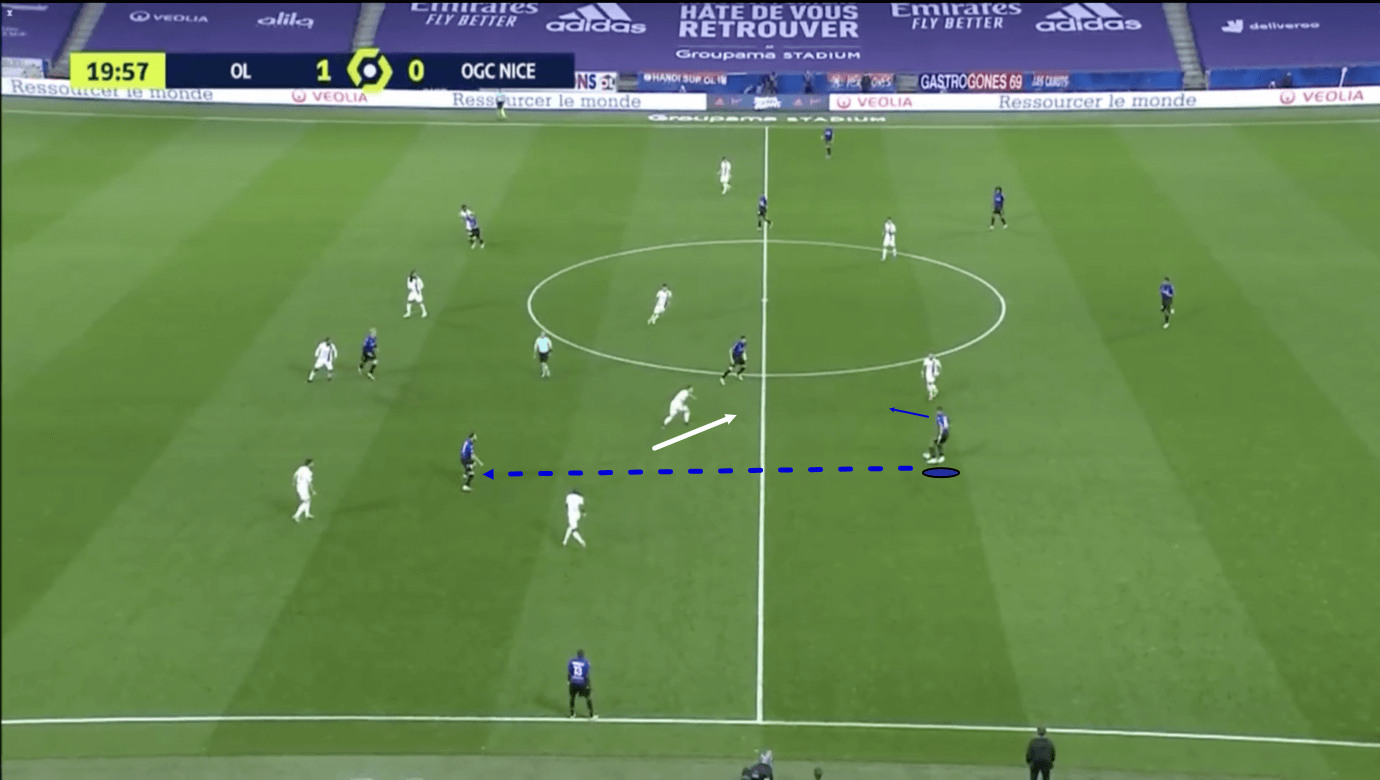
In figure 8, we see a typical example of Saliba playing a progressive pass. He’s carried the ball slightly forward from where he received it here, but not very much. Despite that, he still managed to manipulate the opposition’s defensive shape by dragging the right central midfielder into a more central position, freeing up a passing lane into the left half-space which had been difficult to access. He manipulated this opposition player’s positioning and movement through his body shape.
As Saliba brought the ball forward a little bit, he opened up his body to face the left central midfielder, seemingly indicating that he was about to send a short pass into central midfield. This triggered the opposition’s right central midfielder to get closer to that player. As play moves on, Saliba’s plan comes to light, as he passed the ball straight, despite having shifted his body into a more diagonal position, making use of the player in the left half-space who has become a passing option thanks to the centre-back’s intelligent, subtle body movement. As mentioned previously, Saliba has great vision and a great mind for creating progressive passing situations, as we see an example of here.
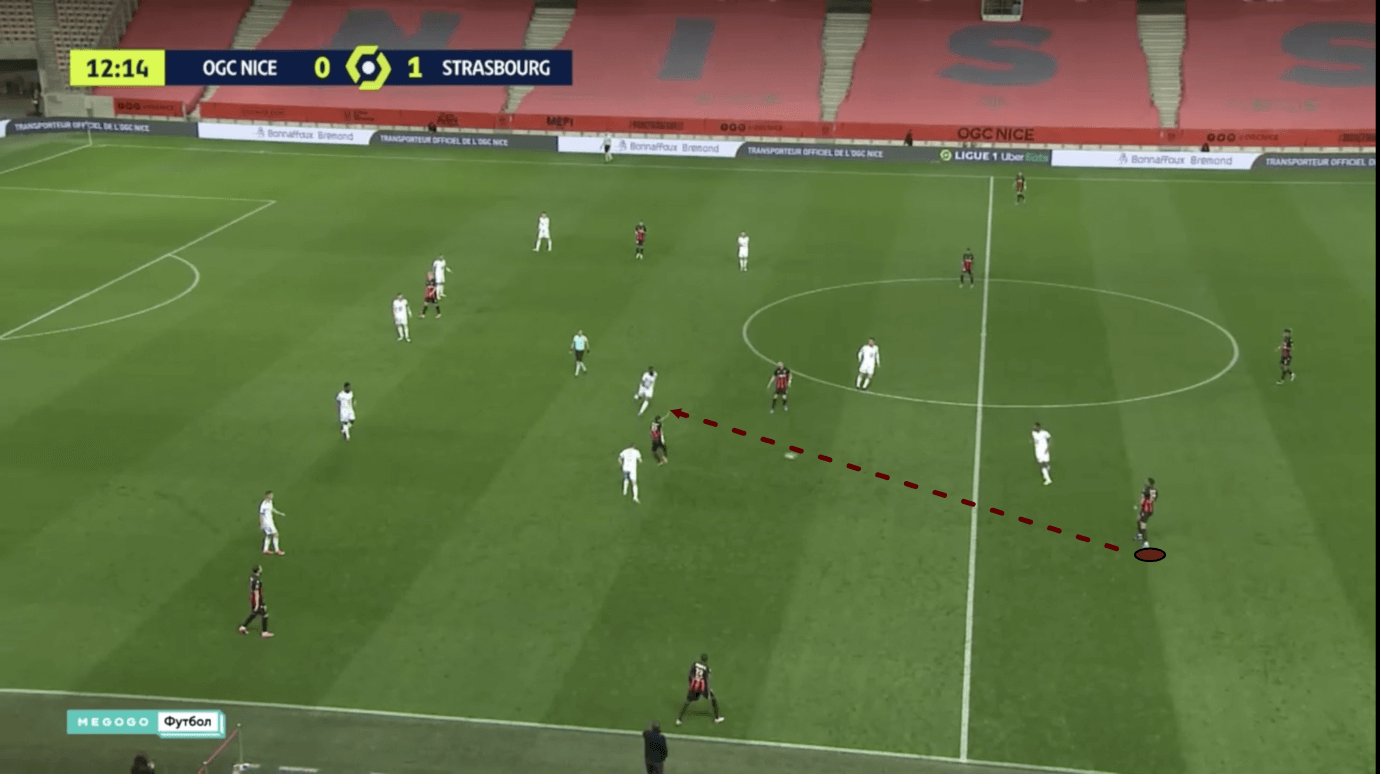
However, as we see in figure 9, Saliba’s passing isn’t perfect. Here, Saliba could have easily passed out to the left-back, continued circulating possession laterally, or taken the riskier option of passing to either of the two central players to his right. He went for the latter despite these players being outnumbered 3-to-2 in midfield. This wouldn’t be terrible if the pass was accurate, however, Saliba misdirects the pass, sending it closer to the opposition player in the centre of this three, who intercepts the ball and starts a counterattack.
Saliba does simply misdirect his passes at times and when playing into more dangerous situations like the one we see here, this can be detrimental to his team. As a result, some work on his technical passing quality is required, as Saliba can improve in this area.
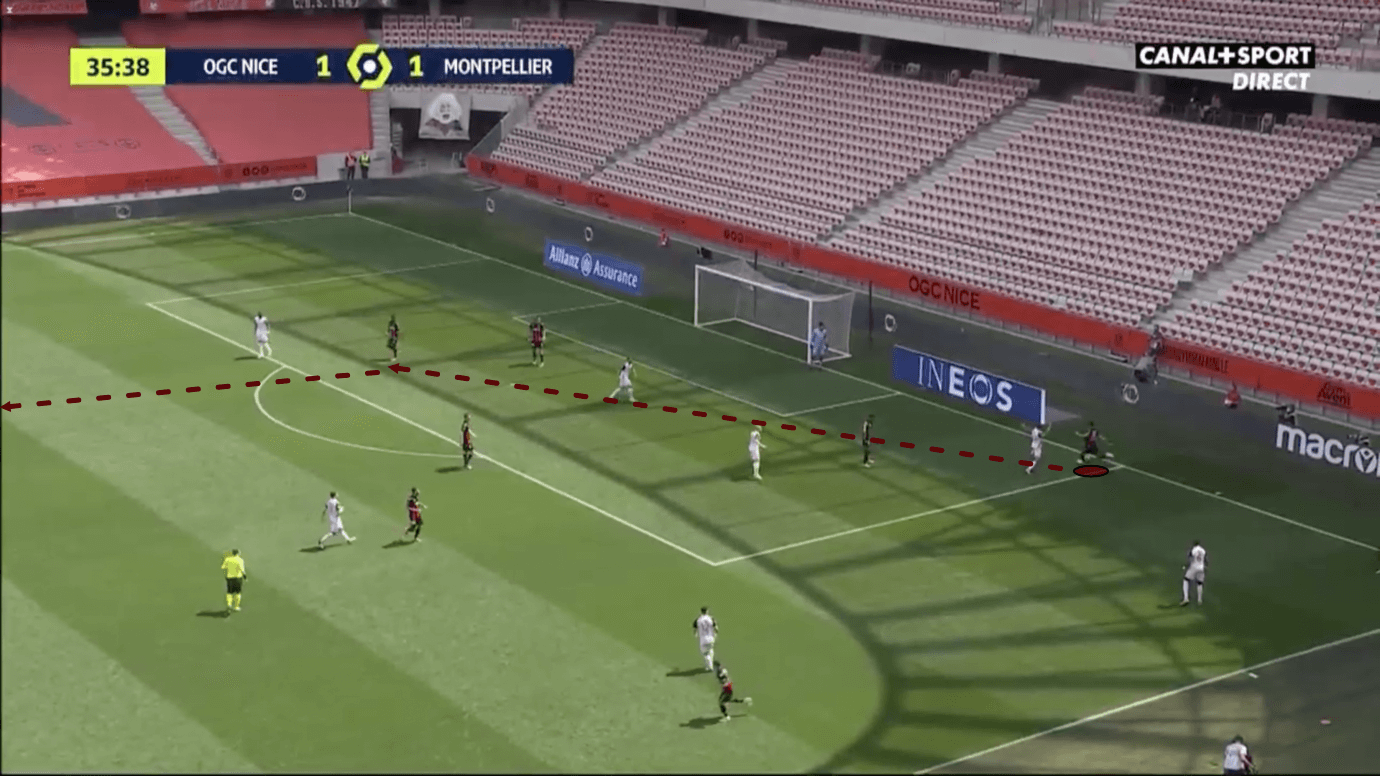
Saliba is generally very reliable under pressure. As we saw in the previous section, he’s happy to allow the opposition to press aggressively, confident in his ability to beat that player. This is true for his ball-carrying under pressure and his passing under pressure. However, Saliba does take a lot of risks with his passing, even under pressure, which could lead to his pass selection being questioned in certain scenarios. In figure 10, for example, we see that Saliba is being pressed right at the byline in his own box, with all near passing options being marked and the opposition pressing with seven players inside Nice’s third.
Despite that, Saliba is reluctant to clear the ball, instead opting to try and get his side playing out from the back with riskier passing. As this passage of play moves on, we see Saliba send the ball across his box through the air and towards the right-back on the opposite side of the penalty area. This player was being marked tightly, while other opposition players were in the box and could’ve taken advantage of the right-back failing to control Saliba’s pass or the centre-back’s pass being misdirected.
Thankfully, for Nice, Saliba’s pass was accurate and the right-back was very calm in this situation, got to the ball first and sent it upfield, so this did work out. However, this ball was a big risk, with plenty of potential mistakes evident. Whether or not this is something that a coach will want to work on with Saliba is up to the coach and how much risk they’re comfortable with taking when playing out from the back. However, knowing that Saliba can misdirect passes at times, a ball like this could be seen as a risk too far and so, pass selection may be something for Arteta to keep in mind with Saliba.
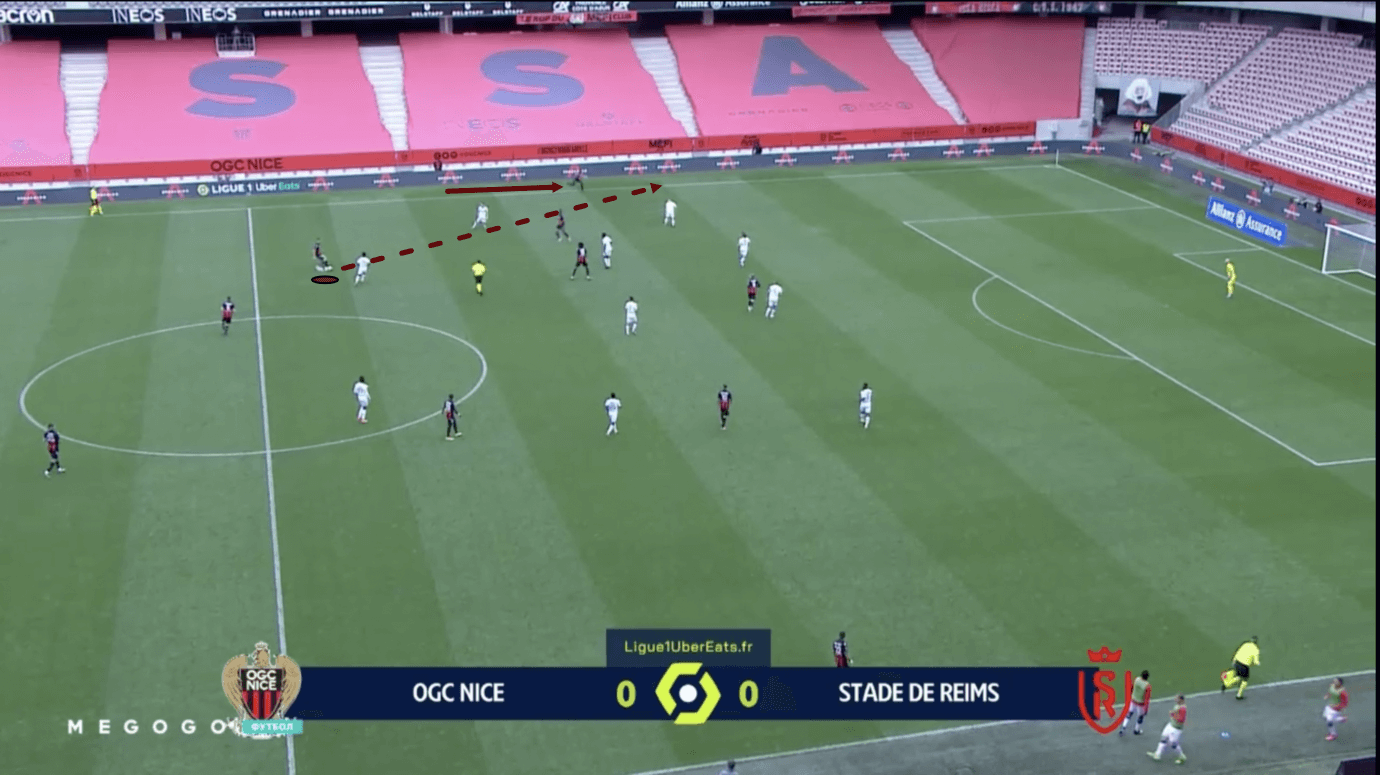
Saliba played 5.44 long passes per 90 this past season – the fourth-most of any Nice player. He also had the fourth-highest long pass accuracy percentage of any Nice player – 62.61%. This is typical of the centre-back role in this Nice squad. Dante, the man who Saliba was arguably brought in to replace in January, was a key deep-lying playmaker in this squad and Saliba played a similar role. While there are players in Ligue 1 who played more long-balls than Saliba and with greater accuracy, he did perform fairly well in this role, though didn’t quite replicate the impressive long passing of Dante – a vastly more experienced ball-playing defender – with some issues evident in his long passing game.
In figure 11, we see an example of Saliba playing a long ball over the opposition’s backline and into his teammate’s running path. This is a positive example of Saliba’s long passing. He was good at spotting runs and often tried to exploit them. In terms of how he technically went about playing long balls, it was common to see Saliba get his head up and take a few short steps before side-footing the ball over the top. He tended to put a lot of backspin on the ball when playing it long, without a lot of curve. Perhaps Saliba could add more variety to his passing technique.
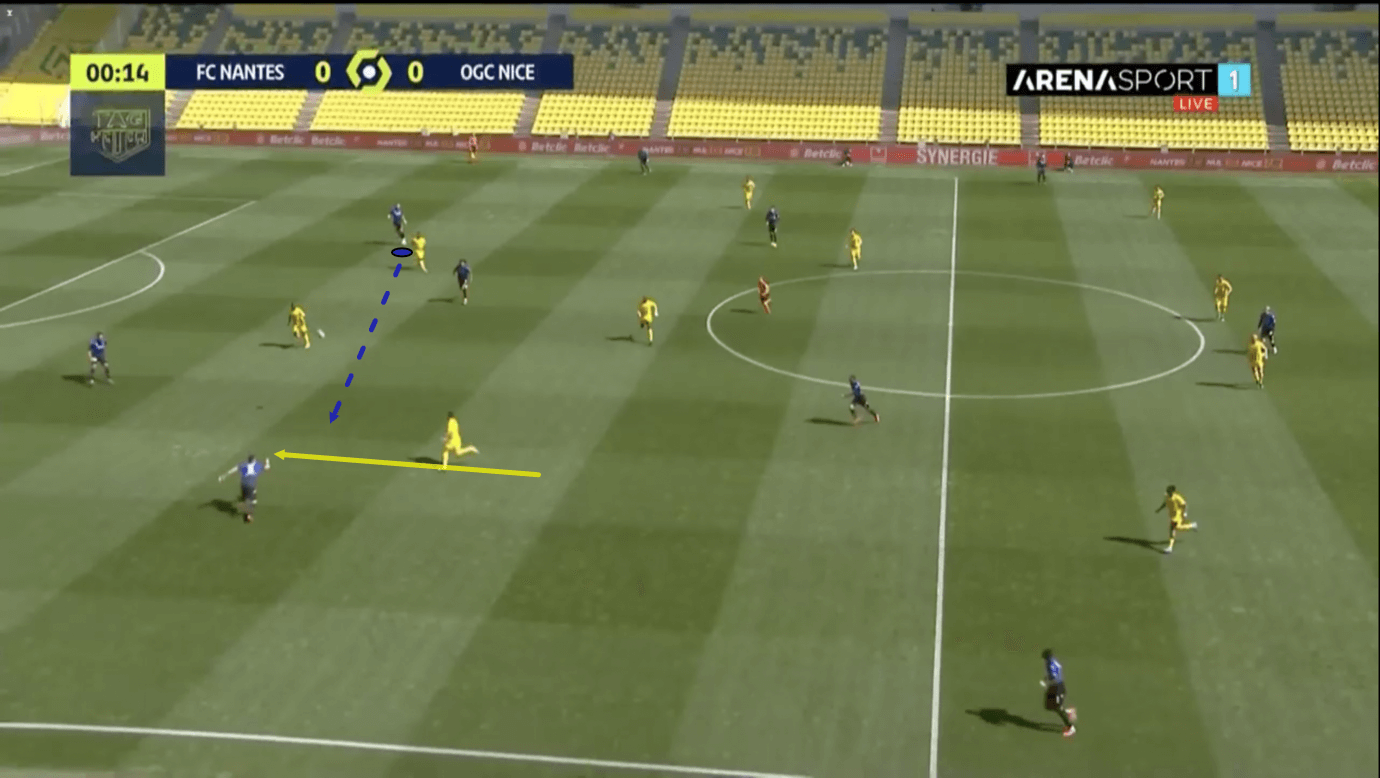
Saliba’s long passing sometimes sees him slicing the ball and sending it behind the intended pass receiver, forcing them to move backwards and halting Nice’s progression, while the centre-back also sometimes struggled to get the power right with his long passes, sometimes under-hitting them and leading to scenarios like the one we see in figure 12, where the opposition can pounce on the underpowered pass and counterattack Nice from a dangerous position. So, we feel that there’s plenty of room for improvement in Saliba’s long passing which could take his game to another level and make him more well-rounded.
Defensive duels
Last season, Nice engaged in just 61.26 defensive duels per 90 – the second-fewest of any Ligue 1 side. Saliba is aggressive in some ways and passive in others – and in terms of defensive duels, he definitely falls into the passive category. He engaged in just 3.31 defensive duels per 90 this past season – the third-fewest of any Nice outfielder. However, Saliba’s defensive duel success rate is very positive. He won 65.71% of his defensive duels in the 2020/21 campaign – the third-most of any Nice player.
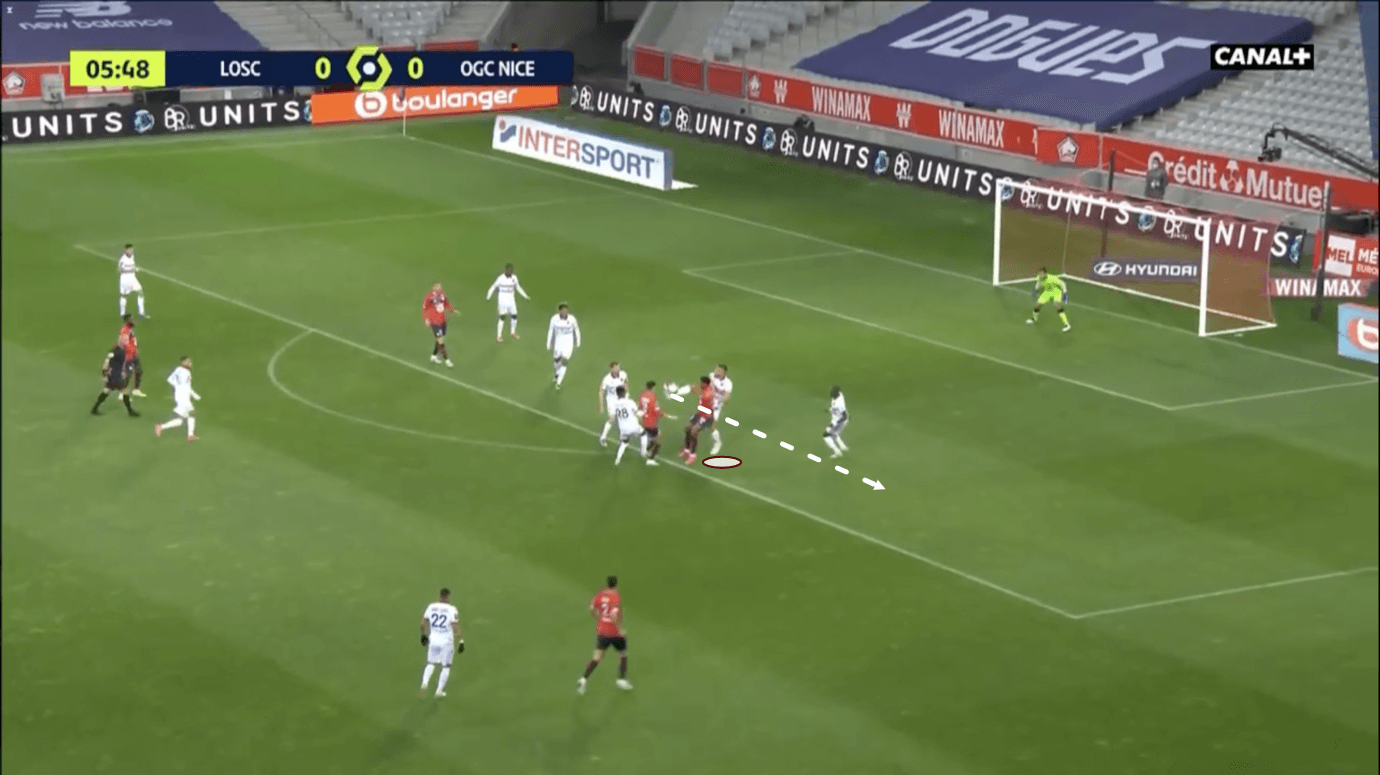
You could argue that this shows Saliba should engage in more defensive duels, however, what it shows to us is that Saliba is selecting his defensive duels very well and tends to only engage in them when it’s a situation that favours him and his defensive qualities. We see an example of Saliba winning a defensive duel in a situation that suits him in figure 13.
Here, Saliba is duelling with an opposition attacker who’s backing into the centre-back. As mentioned at the beginning of this scout report, Saliba stands at 192cm and weighs 85kg. He’s got a very big build, he’s tall and strong, and he’s not easy to bully while backing into him like this. As a result, Saliba isn’t thrown off balance at all and he manages to reach his long leg around the attacker in front of him, knocking the ball away and winning back possession for Nice in a pretty nonchalant manner.
Saliba doesn’t go chasing defensive duels aggressively in more advanced areas of the pitch, he generally likes to hold his ground and avoid defensive duels altogether where possible, preferring to block attackers from moving towards goal, shepherding them away into less favourable positions with his good defensive positioning, good management of space between himself and the attacker, and large body which keeps the space behind him blocked off when combined with his positioning and space management.
Through the use of his large body, Saliba tends to make a lot of blocks. He’s good at this, having blocked 0.85 shots per 90 last season, the 10th-most of any player in Ligue 1. This highlights his defensive style. He isn’t very aggressive and doesn’t engage in defensive duels much. He prefers to ‘sit back’ to an extent and observe play while managing his positioning and distance to keep attackers away from more dangerous positions, biding his time before neatly nicking the ball away when the opportunity presents itself.
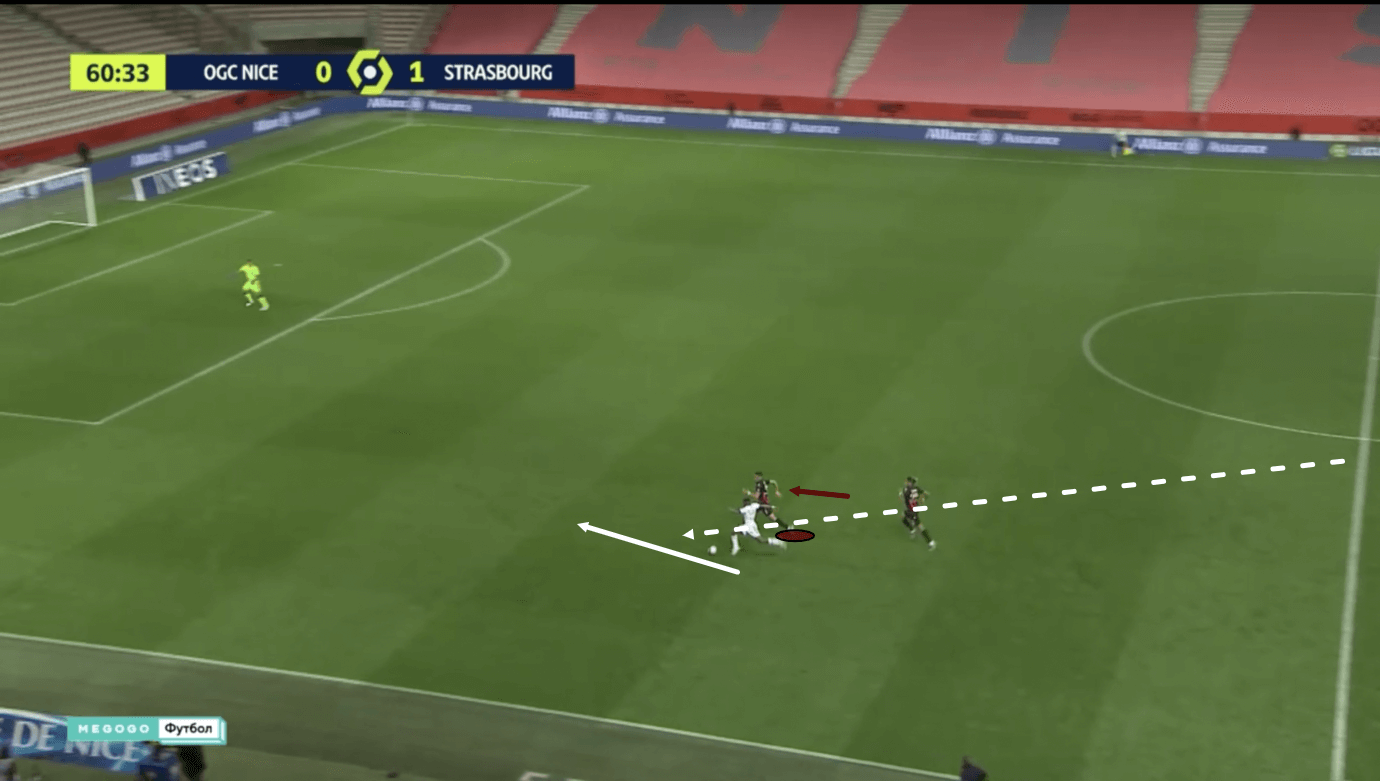
In figure 14, we see Saliba recovering as the opposition try to exploit space behind Nice’s backline. Saliba can be exploited in behind by very pacey attackers, but generally, he’s able to keep up with attackers dribbling in behind. In these situations, similar to the one we just analysed before, Saliba is good at remaining calm, managing his distance from the attacker, and biding his time before engaging. At this moment, in figure 14, we see that Saliba is just trying to match the attacker for speed and prevent him from moving inside via his positioning while observing his movements and waiting for the right time to engage.
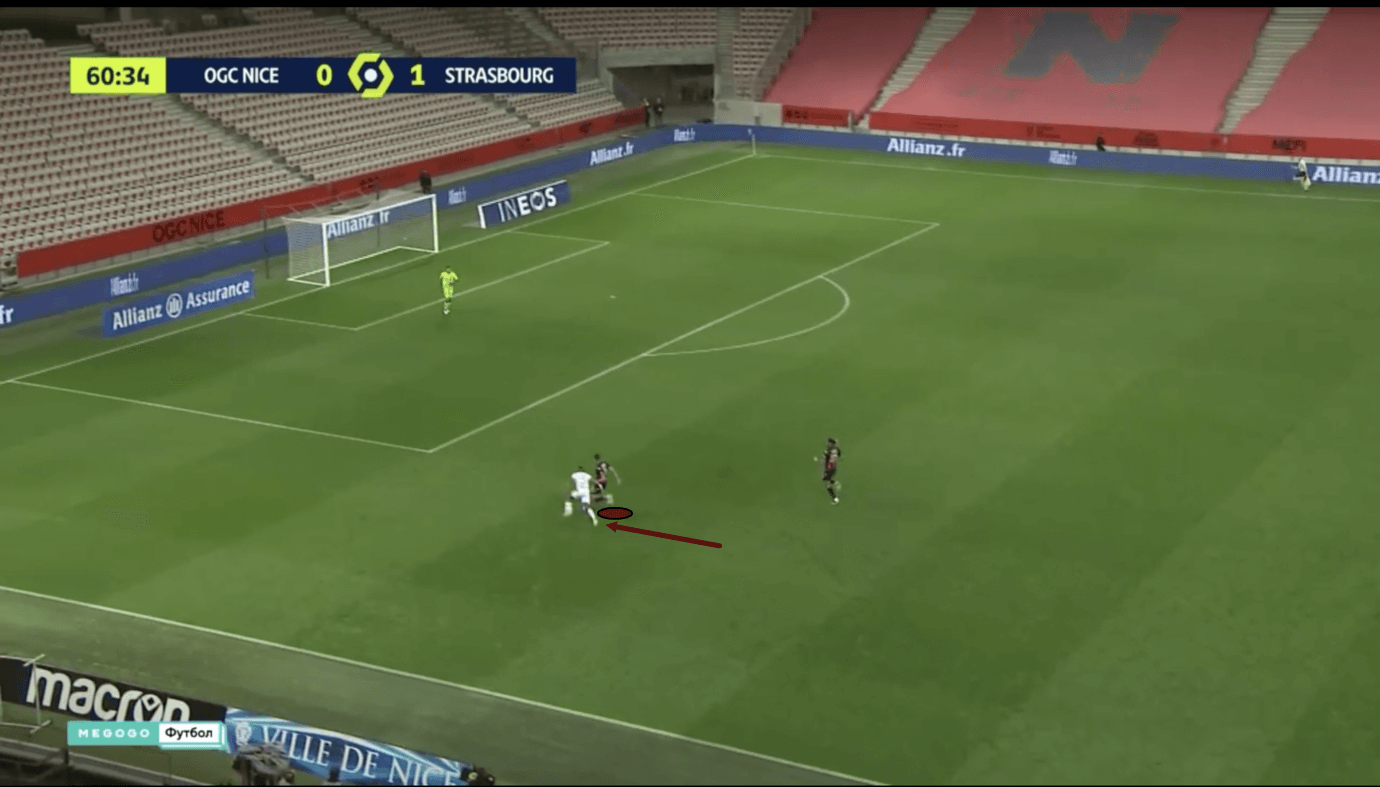
As play moves on into figure 15, the attacker eventually opted to try and beat Saliba for pace and take the ball inside towards goal. To do this, the attacker took a heavy touch – this was the moment that Saliba was waiting for. As the attacker took that heavy touch, Saliba darted in and knocked the ball away, winning possession back for Nice without having to get into too much of a physical battle with the attacker. Despite his size, this is how Saliba likes to defend. He doesn’t like to get too aggressive, instead preferring to wait for his opening and striking at the right moment with his defensive technique.
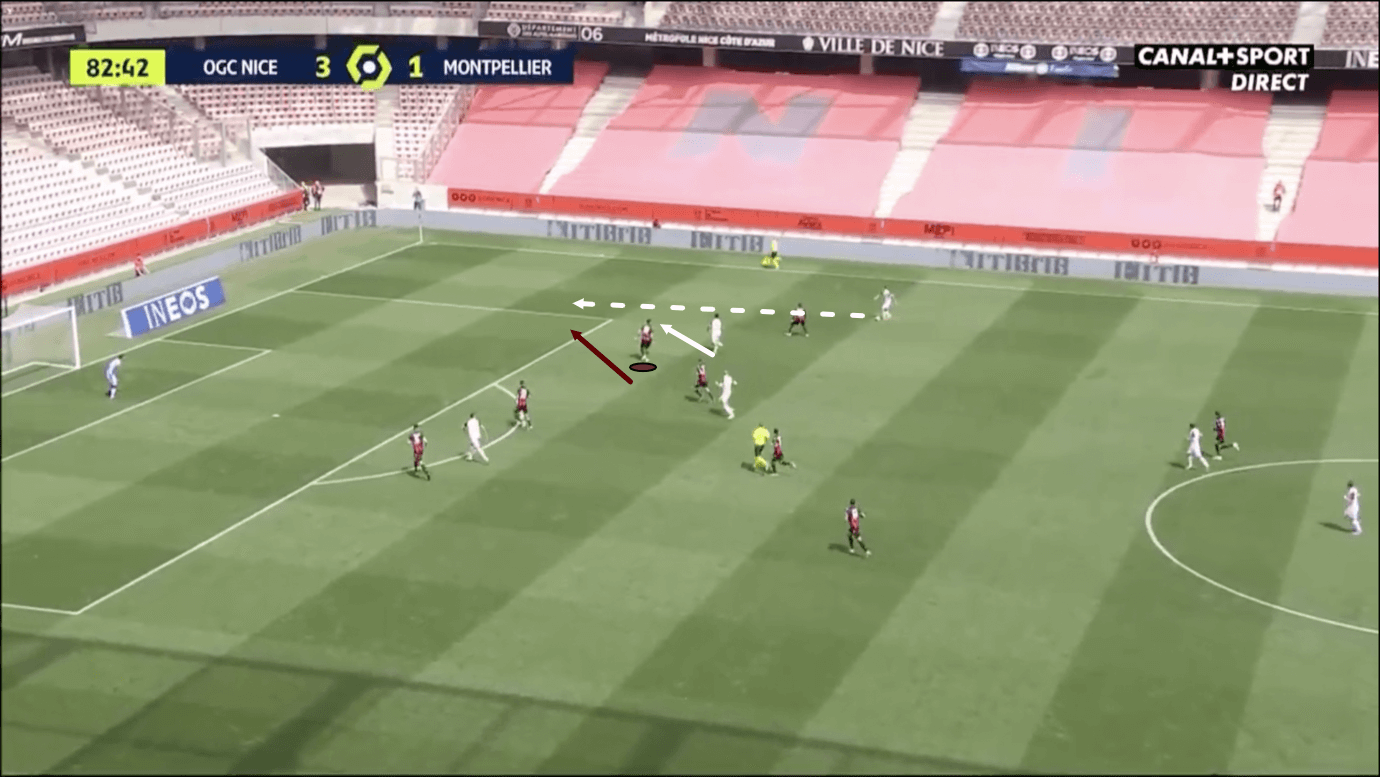
Saliba sometimes struggles when he’s isolated in a 1v1 while positioned in front of goal and against an attacker who’s facing the goal. We see an example of one occasion where Nice’s opponents created this scenario in figure 16. Here, Nice’s left-back was dragged upfield by the opposition’s wide man, resulting in space opening up between that defender and Saliba, which another opposition attacker exploits via his run. The wide man in possession spots this run and plays a through ball to this attacker. This drags Saliba into a 1v1.
This scenario differs from the ones we analysed previously, where in figure 13 we saw Nice defending as a compact unit and Saliba defending against an attacker with his back to him, while in figures 14 and 15, we saw Saliba recovering and moving in the same direction as the attacker. Here, Nice are not as compact, and the attacker is moving towards goal, with Saliba defending him head-on.
The attacker ends up taking the ball towards the byline and Saliba follows. The centre-back engages with the attacker with a shoulder, however, the shoulder was not done aggressively enough to do anything more than just slightly knock the attacker off balance. As a result, the attacker could recover and as play moves on, he carries the ball into Nice’s penalty area and assists a shot in the box.
This highlights how when Saliba is forced to engage in defensive duels in scenarios that don’t suit him, he can be exposed. While he’s got size and strength on his side, Saliba doesn’t always use these qualities when forced to defend more aggressively.
This is not his comfort zone. His size undoubtedly helps him with aerial duels – he engaged in the third-most (3.46 per 90) of any Nice player this past season, impressively winning the 23rd-most (63.01%) of any player in France’s top-flight. However, he doesn’t always use enough force when dragged into ground duels and as a result, attackers can get past him. So, Saliba’s aggressiveness is something for Arteta and his coaching staff to work on. There is nothing at all wrong with how Saliba prefers to defend, but sometimes he’s forced to defend more aggressively and this is where he must be prepared to prevent scenarios like this from recurring.
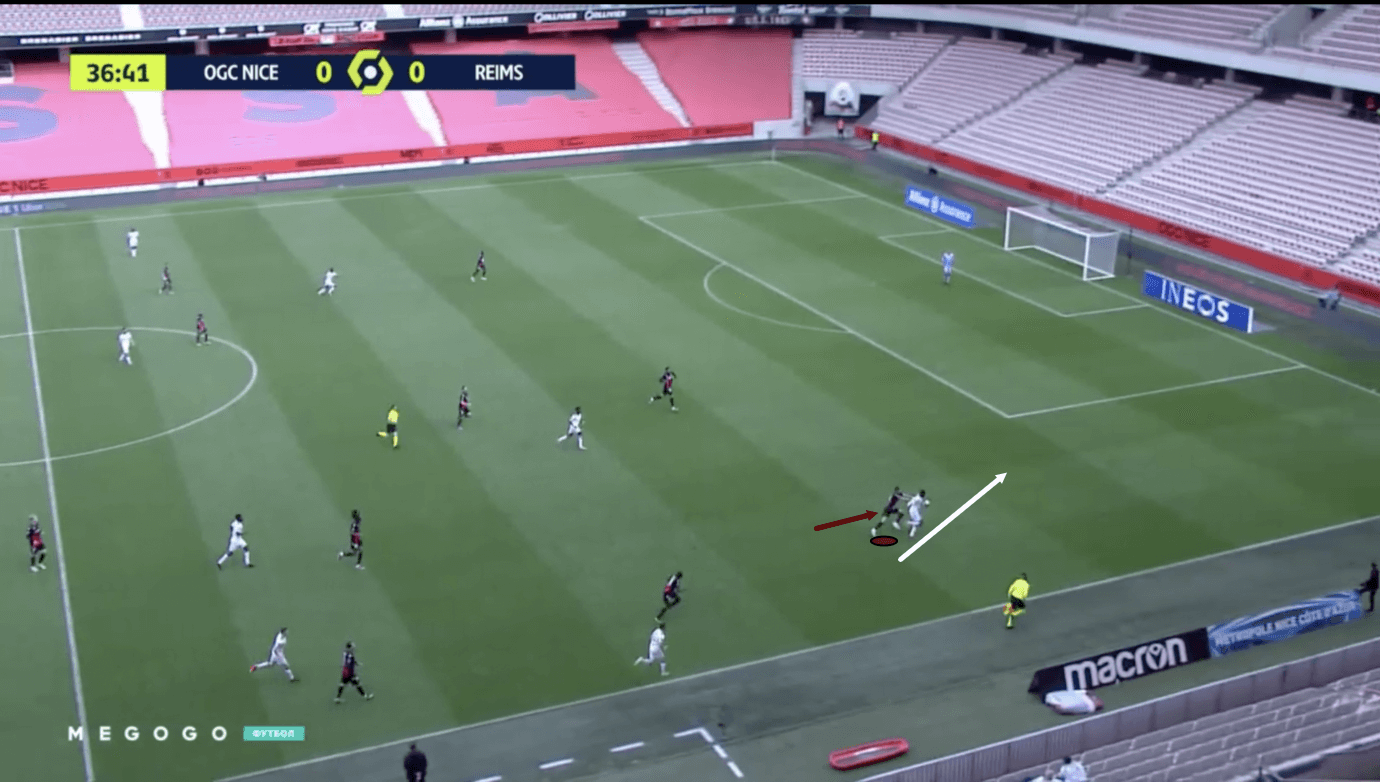
In figure 17, we see another example of Saliba becoming isolated 1v1 out wide. Just before this image, the centre-back got close to the opposition attacker, aiming to prevent him from turning via his positioning as this attacker had the ball played into his feet from deep. However, Nice aren’t very compact here and the attacker had space to move into despite Saliba’s efforts.
As the attacker received the ball, he shifted his weight from the front of his feet to the back and this shift in weight and body positioning helped him to get past Saliba. While the 20-year-old Arsenal man is often able to keep up with attackers moving in behind, he doesn’t turn quickly. This is an area that can be exposed by tricky dribblers who force him to twist inside and outside, so, again, when isolated in 1v1s, there are ways of hurting Saliba. This is something Arsenal’s opponents will want to be aware of next term.
Interceptions
Saliba tends to be more aggressive with his interceptions. The 20-year-old made 5.3 interceptions per 90 last term – the sixth-most of any Nice player.
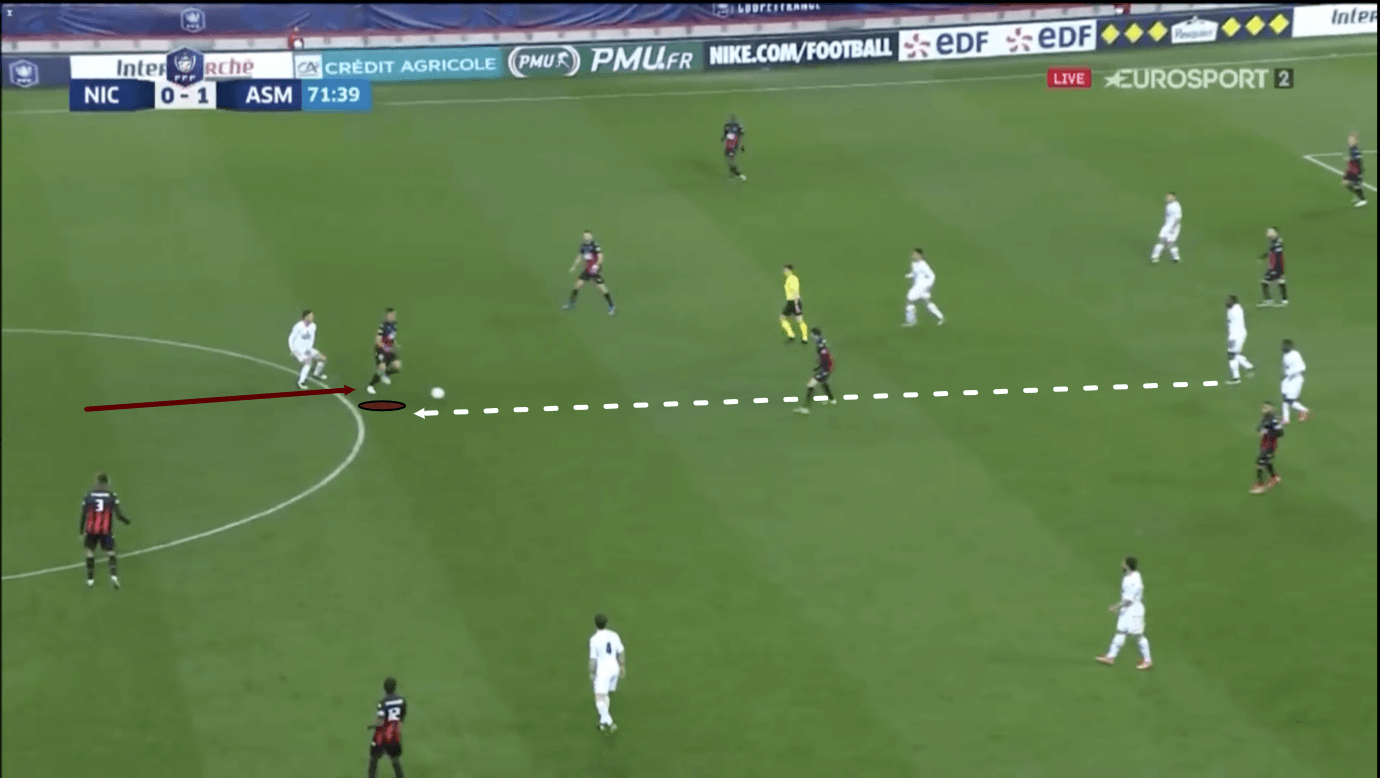
Saliba tends to make most of his interceptions when the ball is being played into an opposition attacker’s feet over a fairly long distance. We see an example of this in figure 18. Here, the opposition are attempting to play through Nice’s midfield to get the ball into an attacker’s feet, however, Saliba was sitting back and observing this, and he managed to quickly get in front of the intended ball receiver to win back possession for Nice.
In the previous section, we mentioned that Saliba doesn’t tend to engage in defensive duels high up the pitch, and that’s true, however, he is comfortable with attempting interceptions in advanced areas of the pitch. He’s got a great ability to read the game and he tends to be quite quick at reacting when passes like this that he could potentially intercept are played. As a result, it’s fairly common to see him jump at opportunities like this, and succeed when doing so.
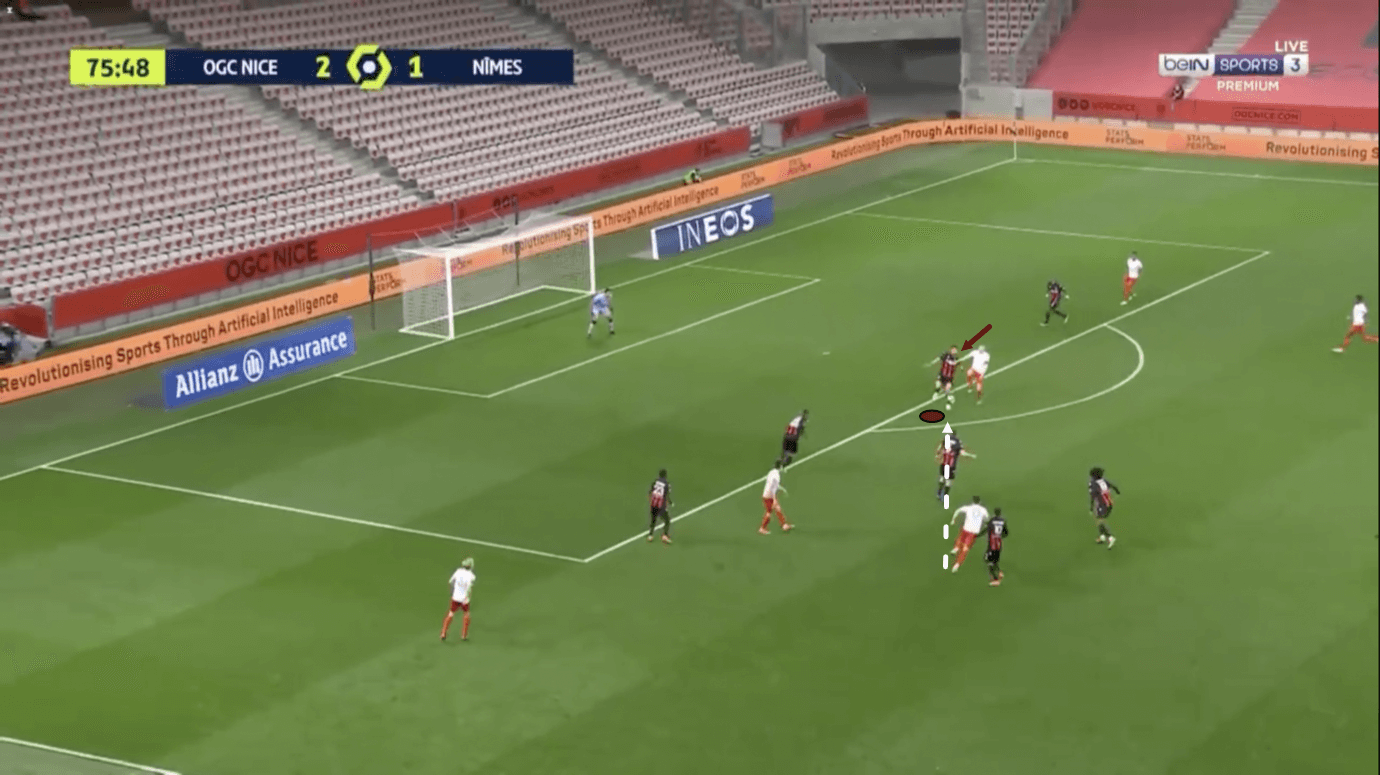
Even when defending deeper, like in figure 19, when the ball is played into an attacker’s feet and he is given enough time to anticipate the pass and jump ahead of the attacker, it’s common to see Saliba take the opportunity to do so. He loves winning the ball back cleanly without having to get messy with the attacker, which his reading of the game and interception-making quality allows him to do.
Conclusion
So, is Saliba ready for Arsenal’s first-team? He defends in a way that suits Arteta’s side. Notably, David Luiz engaged in a similarly low number of defensive duels (3.45 per 90) last season in the EPL, while doing so with a high success rate (70.69%), so this element of Saliba’s game would seemingly translate well to the EPL side. Saliba also had better aerial duel success than any of Arsenal’s centre-backs last season, including Luiz (62%), so this also seems like an area he could help the Gunners.
On the ball, Saliba had a better pass success rate than any Arsenal player last season during his time with Nice, while he also progressed the ball further, per minute, in Ligue 1 than any EPL player bar Chelsea centre-back Thiago Silva did last season. Additionally, Arsenal played the fewest long passes of any EPL side last term, so Saliba may have time to improve in that area before it becomes a real issue.
Saliba will make mistakes next season – that’s a given due to the nature of his game and his age. If he can retain his confidence and bravery despite being under Arsenal’s magnifying glass, he’s got all the technical ability to succeed and eventually iron out the mistakes.
There are some clear areas of improvement in his game, such as his ability to use his physicality in defensive duels, his long passing, and his pass direction/power, however, he’s got plenty to offer, in that he’s a calm, intelligent defender, a great aerial presence, and an excellent ball progressor who loves to take risks and will help his side to create more, even if that leads to chances being conceded.





Comments